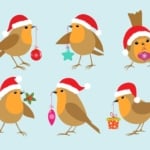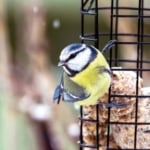Why Having A Fall Bird Feeder Is Great For Birds

A fall bird feeder with healthy, reliable food can help birds stay healthy and migrate more successfully! (Even hummingbirds!)
Below are six frequently asked questions and answers. Read on and use this important information to feel confident as you offer the best nutrition for every feathered friend that flocks to your bird feeder!
1) Do birds become dependent on feeders and lose their foraging skills?
No, a bird feeder is just one more resource for birds. On average, birds tend to get only 10-20 percent of their daily food from feeders and visit many other natural food sources, such as weedy fields, trees, and leaf litter, for the bulk of their meals.
A bird feeder can, however, be more critical when harsh weather may make it harder for birds to forage.
2) What are healthy choices for fall bird feeders?
Sunflower seeds, nuts, and suet are top choices for feeding fall birds. Keeping a nectar feeder available for late-migrating hummingbirds is also a great idea.
3) How can I make a squirrel proof feeder?
Squirrels, chipmunks, raccoons, and other wildlife are just as hungry as birds in autumn and may visit feeders for an easy meal.
Using squirrel baffles (domes or cone-shaped discs) above and below feeders can be a very effective way to create a squirrel proof bird feeder.
Hanging feeders away from trees, rooflines, or fences may also prevent squirrels and other wildlife from jumping onto a feeder.

4) Can bird feeders be bear proofed?
Yes! While bear proofing bird feeders can be tricky because bears are strong and persistent, using poles that are 10-12 feet tall and cementing the poles into the ground can keep feeders safe.
If that isn’t possible, taking feeders in at night and using a seed tray or otherwise cleaning up underneath feeders can minimize the risk of attracting bears to a bird feeder. Be sure other foods, such as trash or compost, are also protected from bears.

5) Do birds need water in fall?
In addition to a fall bird feeder, birds need a reliable source of clean, fresh water year-round—even in areas where there may be puddles or natural water sources.
A bird bath is a great option and will attract even more birds than feeders. Clean the bath every few days and keep it full.
You may want to consider a heated bird bath in areas where winter temperatures dip below freezing, but do not add any chemicals to the water as those chemicals can be very toxic to birds.
6) Do all birds migrate in fall?
No, only about 40 percent of bird species are migratory, though many others may make smaller regional movements, such as traveling around to different food sources or heading up and down mountains in spring and fall.
In fact, many popular backyard birds, including chickadees, woodpeckers, mockingbirds, cardinals, nuthatches, titmice, and quail, stay in their same ranges year-round.
Join The Discussion
Do you have questions about having a fall bird feeder?
Have you tried making a squirrel proof bird feeder?
What are some of your tips and tricks?
Share your experience in the comments below!
Related
Make a bird feeder out of a pumpkin
Bird seed suggestions for winter birds
When To Take Down Your Hummingbird Feeder

Melissa Mayntz
Melissa Mayntz is a writer who specializes in birds and birding, though her work spans a wide range—from folklore to healthy living. Her first book, Migration: Exploring the Remarkable Journeys of Birds was published in 2020. Mayntz also writes for National Wildlife Magazine and The Spruce. Find her at MelissaMayntz.com.












How many of y’all have heard of/done bird feeders from those half gallon juice cartons? You know, made from waxed cardboard like milk used to come in?
I’ve got a couple and want to do a project with my grandson!
I’d like to know how to keep the starlings out. They come here by the hundreds & are nasty to the other birds.
We have two very high platform feeders as well as feeders hanging under the platforms. Each feeder stations has a different type of seed. Our concrete birdbath is elevated on cinder blocks, so any wandering animal is not enticed to use that watering station or jump at the birds. Small bowls are placed on the ground for the wandering animals plus for some of the ground foraging birds. We feed brand name wild bird seed and we have tripled our birds every year. We also attract at least one new species each year. The birds that have babies bring them to our feeders thereby increasing our bird population. The birdbath is scrubbed with a stiff brush every three days. The seed feeders are washed in soap every three weeks. We also plant native flowers and especially any shrub that has a berry. I planted the Spice bushes next to the feeder and it affords the birds a good perching and hiding(summer) place while waiting for room on the feeder.
Also on the subject of Squirrel proofing bird feeders. I have my feeders on a shepherds hook with a slinky strung unto it and the end tied with zip ties. When the squirrel tries to climb the shepherds hook to get to the feeders they are tossed back down and the slinky returns back in place. It is funny to watch them in the beginning trying to get to the feeders but they learn after time that they no longer can.
On the subject of squirrel proofing bird feeders – I keep a tray of peanuts separately for the squirrels, and the little buggers haven’t bothered my bird feeders in 2 years!
Forgot to say this was in western NC
Black bear mom with 3 cubs tried their best to get hummingbird feeders hanging 10’above ground on cemented 4×4. Unfortunately though haven’t seen them since!!